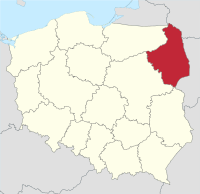Podlaskie
Podlaskie Voivodeship (Polish: województwo podlaskie, [vɔjɛˈvut͡sfɔ pɔdˈlaskʲɛ]) is a province in northeastern Poland.

The vast forests and forests (Białowieża, Augustów, Knyszyń), some of which are the only ones in Europe have retained their original character, you can meet a unique wealth of flora and fauna. The vegetation of the region is extremely rich and diverse, which contributes to the richness of the animal world. Visitors can also see moose, wolves, lynx and bison living in the Bialowieża and Knyszyń forests.
Podlaskie Voivodeship has the lowest population density of the sixteen Polish voivodeships, and its largely unspoiled nature is one of its chief assets. Around 30% of the area of the voivodeship is under legal protection. There are four National Parks (Białowieża National Park, Biebrza National Park, Narew National Park and Wigry National Park), three Landscape Parks (Knyszyń Forest, Łomża and Suwałki), 88 nature reserves, and 15 protected landscape areas. The voivodeship constitutes a part of the ecologically clean area known as "the Green Lungs of Poland".
Cities
- 🌍 Białystok — the capital and biggest city of the voivodeship with the Branicki Palace "the Versailles of the Podlasie"
- 🌍 Augustów — spa in the Suwałki Lakeland
- 🌍 Ciechanowiec
- 🌍 Kuźnica Białostocka — on the border with Belarus
- 🌍 Sejny
- 🌍 Suchowola — geographical centre of Europe
- 🌍 Suwałki
- 🌍 Tykocin — renaissance and early baroque town
- 🌍 Wigry
Other destinations
- 🌍 Białowieża National Park — a UNESCO World Heritage Site as it is the last remnants of the Europe-wide primeval forest from the last ice age, and the last remnants of European bison population
- 🌍 Biebrza National Park — protected swampland haven for birdlife
- 🌍 Narew National Park — national park protecting the wildlife of the river Narew
- 🌍 Wigry National Park — national park protecting the wildlife of the Lake Wigry
Understand
In the early Middle Ages the area was disputed between the Kingdom of Poland, Grand Duchy of Lithuania and Baltic tribes. After the union between the Kingdom of Poland and the Duchy of Lithuania in 1385, Podlasie became the middle part of the Jagiellonian state with major trade routes from the Vistula towns to Vilnius crossing it. Beautiful Baroque palaces, churches and synagogues were built during the Polish-Lithuanian Commonwealth. Besides Roman Catholics, Greek Catholics, Orthodox Christians, and Jews, also the Moslem Tatars settled here since the 17th century. After the Third Partition of Poland in 1795 most of its territory was annexed by Russian Empire. After the Congress of Vienna it became either part of the Kingdom of Poland, ruled by the Russian Tsar, or part of the Russia proper. After World War I, Podlasie became part of the Second Polish Republic; it was occupied by the Soviet Union in 1939-1942, and by Germany between 1942 and 1944. After World War II, it became part of Poland again.
Get in
By plane
There is no international airport in Podlaskie Voivodeship. The nearest Polish airports are Warsaw's Frederic Chopin Airport (WAW IATA) and Modlin Airport (WMI IATA). There are train or bus connections to these airports from towns in Podlaskie Voivodeship, such as Augustów, Łomża, Bielsk Podlaski and Suwałki.
There are also airports in Lithuania, in Vilnius (VNO IATA) and Kaunas (KUN IATA), that are closer to some parts of Podlaskie Voivodeship, such as Augustów or Suwałki.
By train
Polish State Railways have train connections from Warsaw to Bialystok and onwards to Augustów and Suwałki. The train takes two and a half hours and runs every two hours.
By bus
There are bus-services to Białystok from many cities in Poland.
By car
You can easily get there by car.
Get around
See
Do
Eat
Drink
Stay safe
Go next
Podlaskie Voivodeship borders two other Polish provinces:
- Masovian Voivodeship
- and Warmian-Masurian Voivodeship,
as well as countries Russia, Lithuania and Belarus.